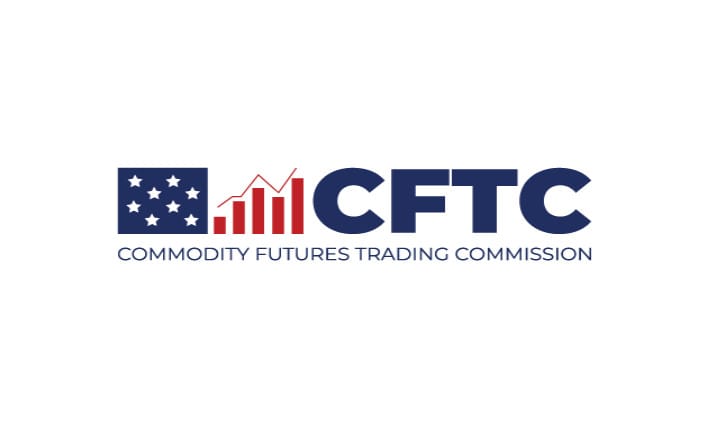The FDIC estimates that the failures of Silicon Valley Bank and Signature Bank resulted in losses of approximately $22.5 billion. $19.2 billion is attributable to the protection of uninsured depositors under the Systemic Risk Exception
Semiannual Update on the DIF Restoration Plan

https://www.fdic.gov/news/board-matters/2023/2023-04-18-notice-dis-a-mem.pdf
Potential losses:
- Losses from past bank failures and reserves related to potential future bank failures affect the reserve ratio by lowering the fund balance.
- In recent years, the DIF has experienced low losses from bank failures, until 2023.
- On average, three banks per year failed between 2016 and 2022, at an average annual cost to the fund of about $178 million.
- Two banks failed thus far in 2023, following more than two years without a bank failure and eight years in a row with few or no failures.
- The failures of Silicon Valley Bank on March 10, 2023, and Signature Bank on March 12, 2023, were due to sudden and unexpected liquidity needs as a result of large withdrawals of uninsured deposits.
- The FDIC estimated the cost to the DIF for these failures to be $20 billion and $2.5 billion, respectively.
- Of that estimated total cost of $22.5 billion, the FDIC estimated that approximately $19.2 billion was attributable to the cost of covering uninsured deposits pursuant to systemic risk determinations made on March 12, 2023.
- By statute, the FDIC is required to recover through special assessments the estimated $19.2 billion of losses to the DIF incurred as a result of the actions of the FDIC pursuant to determinations of systemic risk, and plans to do so through notice-and-comment rulemaking in May 2023.
- As a result, the $19.2 billion in losses to support uninsured deposits will not directly impact the DIF balance because the FDIC is required to collect a special assessment for those losses.
- The remaining estimated loss from these two failures of $3.2 billion will directly impact the DIF balance, however, this estimated loss alone is not expected to have a material effect on the projected timeline for reaching the statutory minimum reserve ratio.
- Staff will provide an updated estimate to the Board that incorporates the effect of recent bank failure activity on the DIF, as well as updated reserves related to potential future bank failures; analyses of longer-term prospects for troubled banks; and trends in CAMELS ratings, failure rates, and loss rates.
- The next semiannual update for 2023 will provide clarity on how losses from past failures and reserves related to potential future failures will affect the reserve ratio.
- While many banking metrics remain sound, uncertainty has increased and significant downside risks persist, with some large institutions experiencing significant funding stress.
- Future economic and banking conditions remain uncertain due to the effects of inflation and higher market interest rates.
- Economic growth slowed in 2022, and the economic outlook for 2023 is weaker, with many economists expecting a recession in 2023.
- The April Blue Chip Economic Indicators consensus forecast for GDP growth is 1.2 percent for full year 2023.
- A weaker economy may reduce bank profitability, weaken credit quality and capital, and limit loan growth.
- Furthermore, higher market interest rates have led to elevated unrealized losses in the banking industry’s securities portfolios.
- Additional short-term interest rate increases combined with longer asset maturities may also affect bank balance sheets in coming quarters.
- As evidenced in the recent bank failures, unrealized losses can also significantly reduce a bank’s liquidity position in the event of unexpected cash outflows that could force the bank to sell securities and realize losses, reducing its regulatory capital.
- Higher market interest rates may also erode real estate and other asset values, as well as hamper the loan repayment ability of borrowers with adjustable rate loans or in need of refinancing.
- The downside risks described above could present challenges and could have longer-term effects on the condition and performance of the economy and the banking industry, which could exacerbate the risk of losses to the DIF.
- The increase in assessment rate schedules that became effective on January 1, 2023, will strengthen the DIF, increasing the likelihood that the reserve ratio will reach the statutory minimum of 1.35 percent by the statutory deadline and promoting public confidence in federal deposit insurance.
- Under the Plan, the FDIC will continue to monitor these and other data to project potential losses to the DIF and to assess their impact on the ability of the reserve ratio to return to 1.35 percent within 8 years of establishing the Plan.
Deposit trends
- Insured deposits increased by 3.3 percent over the last year, below the historical average of 4.5 percent.
- In previous semiannual updates to the Board, staff estimated that excess insured deposits that flowed into banks as the result of actions taken by monetary and fiscal authorities, and by individuals, businesses, and financial market participants in response to the COVID-19 pandemic totaled approximately $1.13 trillion.
- The outlook for insured deposit growth remains uncertain and depends on several factors, including the outlook for inflation, interest rates and consumer behavior.
- An economic slowdown and weaker labor market would reduce consumer incomes and high inflation would constrain consumer budgets.
- These factors could reduce consumer savings and deposit balances.
- On the other hand, concerns about slower than expected economic growth or employment may cause businesses and consumers to maintain caution in spending, and keep deposit levels elevated in order to have the ability to cover expenses or to increase precautionary savings.
- Higher interest rates may also inhibit growth of insured deposits in the banking system, particularly if market rates rise higher than rates paid on deposits.
- This could result in depositors shifting to higher-yielding alternatives outside of deposit accounts.
- Depositor behavior in light of the recent bank failures could also affect deposit trends in the near term. The magnitude and duration of that response at the time of this update remains uncertain.
TLDRS:
- The FDIC estimates that the failures of Silicon Valley Bank and Signature Bank resulted in losses of approximately $22.5 billion. $19.2 billion is attributable to the protection of uninsured depositors under the Systemic Risk Exception--i.e split amongst the remaining banks to pay back the Fed.
- While many banking metrics remain sound, uncertainty has increased and significant downside risks persist, with some large institutions experiencing significant funding stress.
- Future economic and banking conditions remain uncertain due to the effects of inflation and higher market interest rates.
- A weaker economy may reduce bank profitability, weaken credit quality and capital, and limit loan growth.
- Furthermore, higher market interest rates have led to elevated unrealized losses in the banking industry’s securities portfolios.
- Additional short-term interest rate increases combined with longer asset maturities may also affect bank balance sheets in coming quarters.
- As evidenced in the recent bank failures, unrealized losses can also significantly reduce a bank’s liquidity position in the event of unexpected cash outflows that could force the bank to sell securities and realize losses, reducing its regulatory capital.
- Higher market interest rates may also erode real estate and other asset values, as well as hamper the loan repayment ability of borrowers with adjustable rate loans or in need of refinancing.



